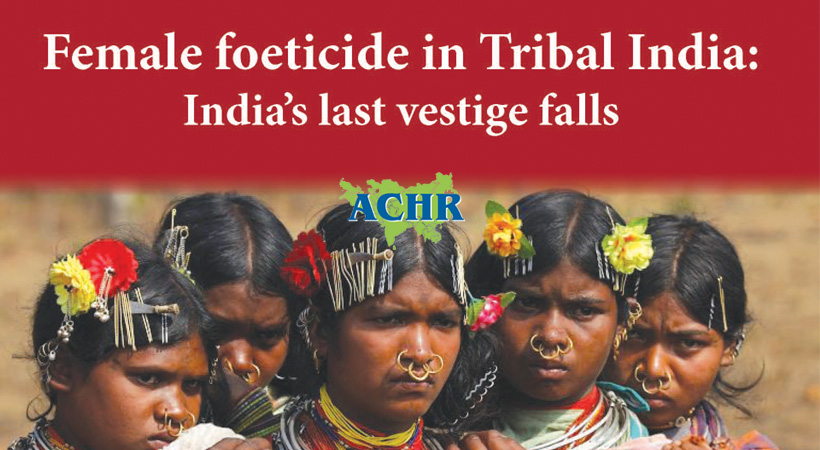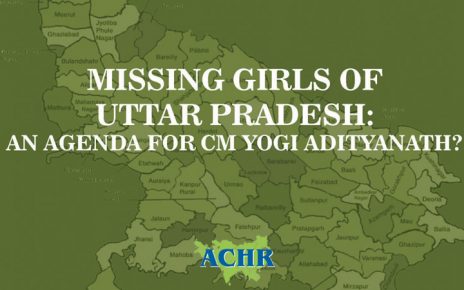India is infamous for female foeticide. It has been witnessing consistent fall in the child sex ratio (CSR): from 976 in 1961 to 964 in 1971 to 962 in 1981 to 945 in 1991 to 927 in 2001 and 919 in 2011. Before the invention of technology for sex determination, India’s CSR was 976 in 1961, 964 in 1971 and 962 in 1981. The highest fall in the CSR from 1981 to 1991 (17 points) and 1991 to 2001 (18 points) confirm beyond any reasonable doubt the misuse of technology for sex selection.
The Scheduled Tribes (STs) because of their egalitarian practices and absence of dowry, one of the primary causes of sex selection leading to female foeticide, are assumed not to practice sex selection. They consistently had much higher CSR. As per 2011 census, the CSR of the Scheduled Tribes (957) was higher than other social groups such as the Scheduled Castes (933) and general population (910).
Yet, the last vestige of India on female foeticide seems to have finally fallen. First, the CSR of the STs decreased from 972 as per 2001 census to 957 in Census 2011, a fall of 15 points which is higher than overall decline in the CSR of the country which was 8 points i.e. from 927 as per 2001 Census to 919 as per 2011 Census. Second, during 2001 census, 120 districts with more than 25 percent ST population had CSR of 950 or more but this declined to 90 districts in 2011.
The falling CSR among the STs indicates increasing preference for sons among STs and by corollary, discrimination against the girl child. The government of India had not implemented any specific schemes for retention of girl child and enforcement of the the Pre-conception and Prenatal Diagnostic Techniques (Prohibition of Sex Selection) Act, 1994 (PC&PNDT) in tribal dominated districts. The absence of any scheme, non-enforcement of the PC&PNDT Act in one hand and easy availability of diagnostic tools for sex determination on the other hand critically contributed to the fall in CSR among the STs.
The Government of India’s Beti Bachao Beti Padao (BBBP) scheme for the first time covers some of the tribal inhabited districts with skewed CSR. However, only 13 out of the 62 tribal districts with more than 25 percent ST population and which witnessed CSR below 950 as per the 2011 Census were included in the 161 districts with low CSR identified for implementation of the BBBP programme. These districts are 1) Dibang Valley in Arunachal Pradesh with CSR of 889; 2) Longleng in Nagaland with CSR of 885; 3) Senapati in Manipur with CSR of 893; 4) Ribhoi in Meghalaya with CSR of 953; 5) Saiha in Mizoram with CSR of 932; 6) North District in Sikkim with CSR of 929; 7) South Tripura District in Tripura with CSR of 951; 8) Nasik in Maharashtra; 9) Raigad in Chhattisgarh, 10) Dausa in Rajasthan; 11) Lakshwadeep in UT of Lakshadweep; 12) Nicobar19 in UT of Andaman & Nicobar Island; and 13) Rajouri20 in Jammu & Kashmir.
Four districts selected under the BBBP scheme namely Morena (Madhya Pradesh), Surat (Gujarat), Ahmednagar (Maharashtra) and Pune (Maharashtra) have partial areas under the Fifth Schedule to the Constitution of India. The district of Kamrup Metropolitan in Assam in North East India with CSR of 946 selected under the BBBP Scheme has ST population of only 5.99% of the total population of the district as per 2011 Census.
The districts selected for implementation of the BBBP from the North East may reach out to the STs simply because the districts are dominated by the STs. However, only six districts out of about 80 districts in the 10 States having areas notified as tribal areas under the Fifth Schedule to the Constitution of India have been selected under the BBBP programme and there is no possibility of the BBBP scheme reaching out to the STs in the absence of specific component to reach out to them.
As the BBBP does not have any specific component to target the STs, it is unlikely to reach out to the tribals. The experiences of the programmes of Tribal Sub-Plan (TSP) not reaching out to the tribals are instructive. As per the Government of India, the prominent reasons for underperformance of TSP funds are: (i) lack of unified planning, implementation and monitoring mechanism, (ii) lack of effective mechanism to gel central plan TSP funds and State Plan TSP Funds, (iii) scattered financial resources used in a scattered manner, (iv) lack of location specific perspective plan, (v) lack of gap analysis, (vi) weakening of institutions specifically meant for delivery of goods and services to tribal population i.e. Integrated Tribal Development Agency (ITDA) / Integrated Tribal Development Projects / Tribal Research Institutes (TRI) and other Micro Projects, (vii) utilization of TSP funds was more ritualistic than outcome based initiative based on gap analysis in Human Development Index (HDI) and (viii) inadequate and insufficient administrative and financial powers with the Tribal Welfare Departments in the States and Ministry of Tribal Affairs at the Centre.
The decline in the CSR among the STs by 15 points in comparison to 8 points for the overall population during 2011 census shows that the programmes for retention of the girl child have not reached to the STs despite schemes such as the Laadli Scheme targeting the BPL families. It is unlikely that the STs will benefit from any of the programmes to address falling CSR except possibly the tribal districts of the North East.
Further, there are serious flaws in the implementation of the BBBP Scheme. As per the BBBP guidelines, one of the key components of the scheme is the effective implementation of the PC&PNDT Act at the national, state and district level. The best practices cited the by the Ministry of Women and Child Development show that there is no case to be cited as best practices of the PC&PNDT Act. Further, the funds remain largely unutilized.
Asian Centre for Human Rights therefore recommends the following to the Government of India especially to the Ministry of Tribal Affairs:
Recommendations:
- Launch a separate scheme to address fall of the CSR among the Scheduled Tribes;
- Ensure that in the implementation of Ladli Schemes, 7.5% of the funds are allocated separately and exclusively for the Scheduled Tribes;
- Ensure that Beti Bachao Beti Padao scheme undertake specific activities in the tribal areas under the 5th Schedule to the Constitution of India and 6th Schedule to the Constitution of India.




